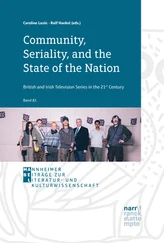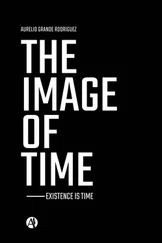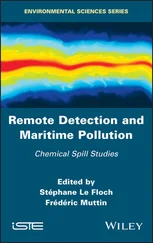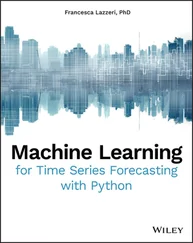1.3.2.1. SCV reconstruction based on multiscale morphological processing
In the standard C 2VA, a SCV indicates a pixel that is unchanged or has a possible kind of change according to its specific signature and constructed change variables (i.e. ρ and θ ). However, the original SCVs may contain abnormal spectral variations and noises, which may lead to a high number of omission and commission errors. To address this problem, the morphological profile (MP) is applied to better model and preserve the geometrical structure of change targets. It is defined as a sequence of mathematical closing and opening operations on the image with different structural element (SE) sizes. In particular, opening by reconstruction ( OR ) and closing by reconstruction ( CR ) (Benediktsson et al . 2005) for a gray-level image f are defined as:
[1.8] 
[1.9] 
where i is the radius of the SE. Here, δi (·) and εi (·) are the dilation and erosion operations, respectively. Rδ and Rε are the geodesic reconstruction by dilation and erosion, respectively. In particular, the components of MP, i.e. OR and CR , are able to suppress brighter and darker regions, respectively, that are smaller than the moving SE, while preserving the geometrical characteristics of a region larger than the SE (Dalla Mura et al . 2010). Small isolated objects are merged into a surrounding local background while the main structure is kept. Due to the fact that different image objects usually have different sizes, multiscale representation allows us to explore different hypothetical spatial domains by using a range of SE sizes, in order to obtain the best response for different structures (Mura et al . 2008).

Figure 1.3. Block scheme of the proposed M 2 C 2 VA technique
For the B -dimensional SCVs X D, at a given scale i , its OR and CR are also B -dimensional:
[1.10] 
[1.11] 
Note that either  can be used as an input for the detector (e.g. S 2CVA), but ambiguities may arise due to the selection of a specific operator (i.e. OR or CR ) and its consequential effects (i.e. suppression of brighter or darker objects). The joint use of OR and CR is likely to be more reliable. In this work, the four-connected neighborhood was considered, and the marker and mask image represented the dilation result and the original input band (for OR ) (or complement image of the original input band for CR ), respectively. A disk shape was selected for the SE, which has been demonstrated to be a robust shape in different scenarios (Benediktsson et al . 2005; Mura et al . 2008). The size of the SE i was increased from 1 to 6, in order to implement a multiscale analysis using the reconstructed SCVs.
can be used as an input for the detector (e.g. S 2CVA), but ambiguities may arise due to the selection of a specific operator (i.e. OR or CR ) and its consequential effects (i.e. suppression of brighter or darker objects). The joint use of OR and CR is likely to be more reliable. In this work, the four-connected neighborhood was considered, and the marker and mask image represented the dilation result and the original input band (for OR ) (or complement image of the original input band for CR ), respectively. A disk shape was selected for the SE, which has been demonstrated to be a robust shape in different scenarios (Benediktsson et al . 2005; Mura et al . 2008). The size of the SE i was increased from 1 to 6, in order to implement a multiscale analysis using the reconstructed SCVs.
1.3.2.2. Multiscale change information ensemble
By increasing the size of the SE, change objects can be modeled at different scales, while exploring the interaction with the surrounding regions to preserve more geometrical details. Accordingly, a more comprehensive description of change objects is obtained through multiscale analysis. Therefore, a multiscale ensemble is conducted on the reconstructed SCVs. Let  be the stacking of the reconstructed SCVs (i.e.
be the stacking of the reconstructed SCVs (i.e.  at a given size i , having a dimensionality of 2 × B. It is defined as:
at a given size i , having a dimensionality of 2 × B. It is defined as:
[1.12] 
Then, the extended SCV  is defined as an integration of sequential
is defined as an integration of sequential  with lower and upper bounds equal to u and v , respectively:
with lower and upper bounds equal to u and v , respectively:
[1.13] 
Consequently, an extended SCV feature set with 2× B×M dimensionality is built, where M is the length of components in the sequence, i.e. M = v − u + 1. It is worth noting that S[u, v] extends the change representation along the spectral direction, as well as considering the multiscale spatial information in the ensemble process. Then, S[u, v] is used as the input for the detector.

Figure 1.4. Block scheme of the proposed superpixel-level multiclass CD approach
1.3.2.3. Multiclass change representation and discrimination
The aim of this step is to visualize and discriminate multiclass changes present in the reconstructed SCVs. To this end, the S 2CVA detector introduced in section 1.3.1 is applied on the S[u, v] . Note that the detector exploits not only spectral variations, but also spatial variations represented in the reconstructed SCV components. It is also worth noting that the 2D polar scattergram projects multiclass change information from the considered high-dimensional reconstructed SCVs into a low-dimensional (i.e. 2D) feature space, which is lossy and ambiguous on the type of changes. However, the most significant discriminative information of different changes is preserved.
Instead of using thresholding to segment the binary and multiple classes in the variables ρ and θ , the simple but effective clustering, i.e. k -means, is used for generating the final CD map, which does not rely on any specific data distribution. This is due to the fact that changed and unchanged pixels in ρ and multiclass changes in θ do not always follow a Gaussian mixture distribution (Zanetti et al . 2015). Thus, for the binary CD step (i.e. separating two classes), the number of clusters kρ is equal to 2, and for the multiclass CD step, the number kθ is defined as the number of changes observed in the 2D polar scattergram.
Читать дальше
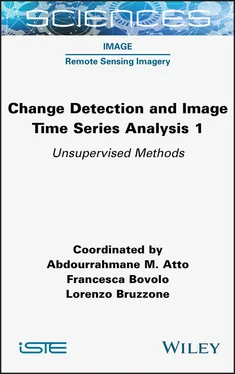





 can be used as an input for the detector (e.g. S 2CVA), but ambiguities may arise due to the selection of a specific operator (i.e. OR or CR ) and its consequential effects (i.e. suppression of brighter or darker objects). The joint use of OR and CR is likely to be more reliable. In this work, the four-connected neighborhood was considered, and the marker and mask image represented the dilation result and the original input band (for OR ) (or complement image of the original input band for CR ), respectively. A disk shape was selected for the SE, which has been demonstrated to be a robust shape in different scenarios (Benediktsson et al . 2005; Mura et al . 2008). The size of the SE i was increased from 1 to 6, in order to implement a multiscale analysis using the reconstructed SCVs.
can be used as an input for the detector (e.g. S 2CVA), but ambiguities may arise due to the selection of a specific operator (i.e. OR or CR ) and its consequential effects (i.e. suppression of brighter or darker objects). The joint use of OR and CR is likely to be more reliable. In this work, the four-connected neighborhood was considered, and the marker and mask image represented the dilation result and the original input band (for OR ) (or complement image of the original input band for CR ), respectively. A disk shape was selected for the SE, which has been demonstrated to be a robust shape in different scenarios (Benediktsson et al . 2005; Mura et al . 2008). The size of the SE i was increased from 1 to 6, in order to implement a multiscale analysis using the reconstructed SCVs. be the stacking of the reconstructed SCVs (i.e.
be the stacking of the reconstructed SCVs (i.e.  at a given size i , having a dimensionality of 2 × B. It is defined as:
at a given size i , having a dimensionality of 2 × B. It is defined as:
 is defined as an integration of sequential
is defined as an integration of sequential  with lower and upper bounds equal to u and v , respectively:
with lower and upper bounds equal to u and v , respectively:



